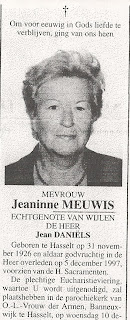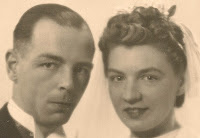Whether he was the first Doelman to have this coat of arms is doubtful. There are earlier records showing a similar coat of arms. It belonged to a Cornelis Michielsz Doelman, alderman until 1566. It is unknown how Frans is related to this Cornelis.
In 1658 a farm was built in Maasland. Ever since the early 19th century this farm was known as the Doelman's farm (Doelmanshoeve). In this farm there was, and still is a stained glass window showing a Doelman coat of arms (right). There is a great resemblance to the one shown above. The farm still exists but now as a restaurant called the De Ridderhof (The Knight's Court).
In the Armorial Général, the very impressive heraldic work by J.B. Rietstap, the Doelman coat of arms is described as you can see below.
 |
| Excerpt from the Armorial Général |
I am not sure that this description fits both coat of arms shown in this post. I am not even certain what it means...
When the last owner of the Doelman's farm died on Dec. 4, 1916, he was buried in Maasland. His name was Adrianus Doelman and he lived to be 79 years old. It is said that his coat of arms is part of his tombstone. So I better go there before weathering makes it impossible to see how it looks like. But I trust that also there the man's face at the top of the coat of arms resembles the face of a Doelman. Because that's what Granny told me. And if ever there was a truthful woman, it was Granny!
*Contrary to popular belief a coat of arms does not automatically imply nobility. But rest assured, even today it is possible to design a coat of arms for your family and have it registered. In the Netherlands registration is possible via the services of the Central Bureau of Genealogy (CBG) or the Dutch Genealogical Society (NGV).

.jpg)


.jpg)










